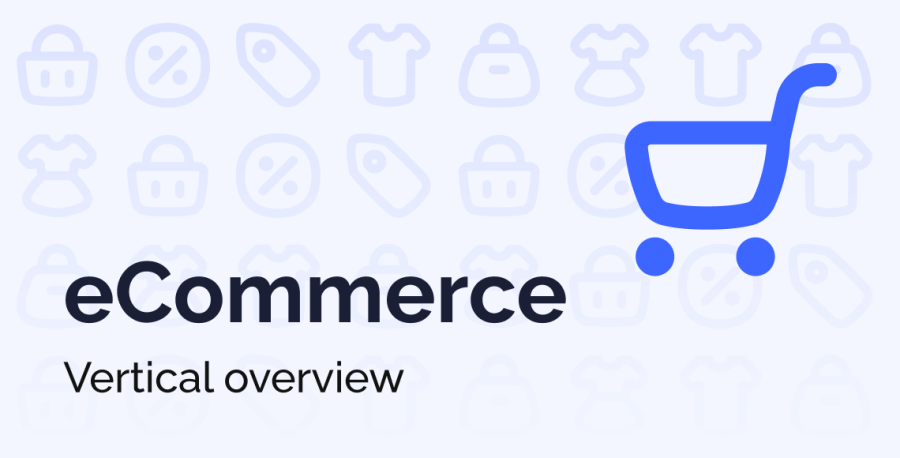The vertical of eCommerce grows more popular day by day. eCommerce is easy to enter but hard to perfect. Shopping online is convenient, affordable, and fast — which is why consumer’s demand persists. The recent COVID-19 pandemic gave it a second wind, and facilitated eCommerce growth by 19% — shopping madness at its best.
Speaking of which, we have a November promo with the same name — more details in the article. Even though eCommerce is newbie-friendly, and advertisers tolerate diverse traffic sources, it has some caveats you are better off knowing about in advance prior to delving deeper into it. That’s the reason behind the creation of this article — read on to learn all the basics about profiting on eCommerce vertical.
Definition & Facts
eCommerce (electronic commerce) is the exchange of goods & services and funds & data over the internet. Besides the internet, eCommerce is grounded in websites, mobile apps, social media, encryption, digital money, gadgets — that’s just a tip of the iceberg. It encompasses programming, marketing, web designing, linguistics, psychology, and many other arts & sciences. That’s all nice and stuff, but why should a fellow affiliate care about the eCommerce vertical?
Because there is untapped potential. Every third person you meet frequents online stores. As of 2023, about 2.64 billion of people (33.4% of the world) shop online. This number is expected to grow: 2.71 billion of people in 2024 and 2.77 billion in 2025. Among those 2.64 billion, more than 40% already prefer to use cellphones to purchase goods & services, and the percentage is expected to grow. It is expected that by 2024, the users will spend $6.767 billion online — that’s 22% of all retail sales.
Anything can be sold online. Clothing and fashion items enjoy the highest demand, but there are others: electronics & accessories, health & beauty products, nutra & food, sports & travel stuff, booking & tickets, even non-fungible tokens!
Consumer’s demand for eCommerce is persistent, but not all the advertisers are able to increase the awareness of their products. That’s where affiliate marketing comes into play — the art of promoting products online and earning commission for doing that successfully. Whether you are an affiliate (advertiser) or publisher, eCommerce is an evergreen vertical, meaning you can profit 24/7 throughout a year.
Pros & Cons of eCommerce
Take a look at the advantages and disadvantages below to see whether this vertical suits your marketing needs. Here are the pros:
- Low entry threshold — eCommerce is an ideal vertical for beginners
- Few bans — the whole vertical is moderation-friendly, which is why many affiliates even use just a single account to drive all the traffic
- Big selection of GEO — as long as the internet is present, people will look to buy something online
- Wide range of sources — the users ought to convert, the rest is out of the question; use Google, FB, social networks, pushes, pop-unders etc.
- Simpler conversion — the users can be pre-engaged and don’t lose much after ordering a product that does not meet their desires
- Fast payments — the user usually pays during checkout, which is why the commission can also be paid faster
Time to mention the cons:
- Unimpressive payouts — can be offset with massive traffic volume and frequent conversions
- Stiff competition — eCommerce has its own “sharks”, and there are plenty of newbies too
- GEO limitations — some GEOs have few advertisers, making work with them difficult
The user, however, does not always pay right away — sometimes, they may be inclined to pay after receiving the goods. If, for some reason, the client doesn’t pay for the goods, the affiliate is not rewarded for the lead, even if the quality of traffic is supreme.
All the eCommerce offers are subject to “hat-coloring”. Depending on your subniche, some pros & cons may shift a bit. Talking about eCommerce subniches:
- Whitehat — the default format, which enjoys all the pros from above: clothing, toys, electronics, amulets, gifts
- Greyhat — a common subtype, with the goods that can confuse the user: counterfeit watches, lucky amulets, fake smartphones
- Blackhat — goods that are illegal to promote: guns, drugs, precursor chemicals, projectiles, explosives
It should be noted that different platforms, e.g., Amazon Ads or Google, have different ads policies. Moreover, RollerAds have terms & conditions of our own. Make sure to read the guidelines of every web platform involved — ignorance is not an excuse.
In Search for Traffic
eCommerce is an evergreen vertical in general, because people always want to buy something. There are two most prominent traffic sources for eCommerce.
Search engines. Obviously, people use Google and other search engines to look for info online. By purchasing ads on Google, Bing, Yahoo, and some local alternatives, you can effectively reach out to new users and start collecting a database of them. Then, you can contact those users with follow-up email campaigns.
Social networks. 4.8 billion people frequent social media, which is about 60% of the population. However, each mainstream social network has a specialization. For example:
- Twitter is about short messages, which attracts the youth, educated, and business-oriented individuals
- LinkedIn has a more serious tone to it, which is a bait for upper-income professionals and educated individuals
- Facebook is the most versatile option
- Instagram is favored by female audience, photographers, and designers.
- YouTube is the king of video ads, where people spend 40 minutes on average
- Pinterest is visited by women even more often than Instagram
Whether you are going for SEO or PPC, make sure to pay special attention to Push-notifications and Popunders (a.k.a. Onclicks). These two ad formats are robust and pair well with almost any traffic sources, at least when it comes to eCommerce.
Best Creatives & Practices
Let’s start with creatives. Despite the fact that the creatives for eCommerce are relatively long-living, you still need to take your time and make them good. Some of the best creatives out there capitalize on one of the following approaches:
- Emotion-evoking messages, e.g., sometimes you should play with your food (marshmallows ad)
- Borderline-obscene ideas, e.g., do you know where that soap was used (liquid soap ad)
- Shocking content, e.g., moldy whopper (Burgerking)
- Modern culture references, e.g., Harold Hide the Pain and COVID-19 vaccination
- Personalized ads, e.g., Share-a-Coke (Coca-Cola & people names)
Use spy-tools. Monitor the creatives of other affiliates and pay special attention to which offer they belong to. If an offer has tons of creatives — you are into hard times because of the increased competition. However, relatively few creatives is not necessarily a good sign either — the conditions might be awful or its conversion rate is low. Still, make sure to test all the offers with few creatives — you might locate an unexplored gold mine. Or simply visit our Creatives library, where we have prepared the best creatives for you already — just take them!
Check call-centers. Unlike other verticals, eCommerce involves more than just an affiliate and their quality of traffic. This traffic is to be processed by call-centers, which might spoil even the flawless funnels. Before running an offer, ask your affiliate manager or the advertiser about the details of how the call-center works. On top of that, make a testing request and see how fast you will get the response. Advertisers might outsource call-center services or have in-house staff. In case of the former, the quality will be inevitably lower.
Monitor promo-events. Remember about seasonal holidays and sales, like Black Friday, Valentine’s Day, Back to School sales. Our promos usually follow the global trends, consider our Shopping Madness, for example. Promote some eCommerce or OnClick campaigns during November, the month of Black Friday & Cyber Monday, to get rewarded with hefty cashback.
Read the reviews. If there are a lot of reviews online, some of which are very old — the offer’s potential might have been squeezed out already. Few reviews indicate that the offer is young and unused. Keep in mind, if you can find a lot of negative reviews online, so can your potential customers do.
Contact your affiliate manager. The AM and you have your goals aligned — to generate more profit. The job of AM depends on your success, which is why they will always tell you about the best offers, how to promote them efficiently, and all the related caveats. However, even the AM’s word is not an excuse not to test. Split-testing is of supreme importance for data-driven decisions.
Checkout Page: Multi or Single?
All the steps above bring us closer to the checkout page. This is where the main challenge begins — how to convert the user? On average, only 1.94% of eCommerce website visits end up in a purchase. The average cart abandonment rate is 70%, i.e., 7 out of 10 customers leave your page empty-handed. By countering it, you can enjoy a huge surge of well-deserved traffic.
An ideal checkout page ought to do the following:
- Minimize customer’s risk, e.g., link to terms & conditions
- Improve user’s trust, e.g., payment trust seals
- Remove psychological roadblocks, e.g., facilitate purchasing with few-to-no obstacles
- Tackle doubt and uncertainty
- Create a sense of urgency, e.g., timers & countdowns
- Have access to live chat button
- Add variability, e.g., discount codes & cross promo
Following all the points is impossible due to an inevitable contradiction — an informative multi-stage checkout page or a brief single-stage one? There is no clear winner, but multi-stage checkout tends to have less complex forms. You can deliver information gradually, without scaring off the user from the get-go. To ease their anxiety, include a special progress bar, showing how much left till the order is complete.
Conclusion
eCommerce is a great evergreen vertical for both the beginners and experienced affiliates. To some degree, it’s sure-fire with relatively little risk involved, which is why the payouts are humbler, compared to other verticals.
Still, eCommerce offers are many, worldwide available, and relatively simple to promote. Including a few in your portfolio is a good idea to have a stable source of income. Just make sure to have more than just one. Read the reviews, check the work of call-centers, communicate with your AM, test diligently, and you will find your profit.
Speaking of profit, we remind you about our special promo, called Shopping Madness. It is about getting cashback for running eCommerce or OnClick offers — come, check it out. Contact RollerAds if you need any help and have a good day, chaps.





